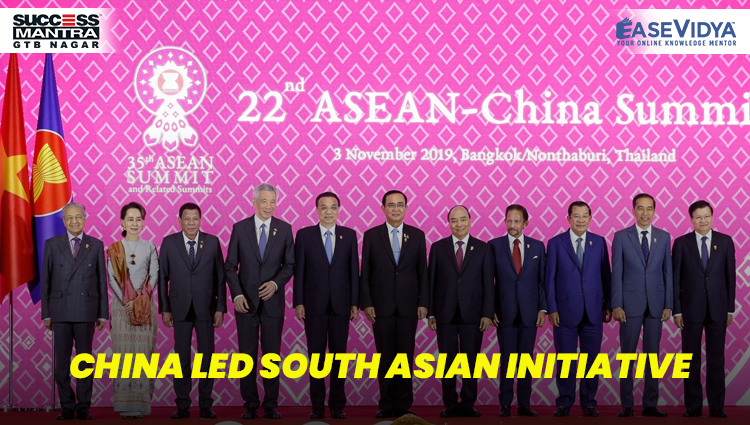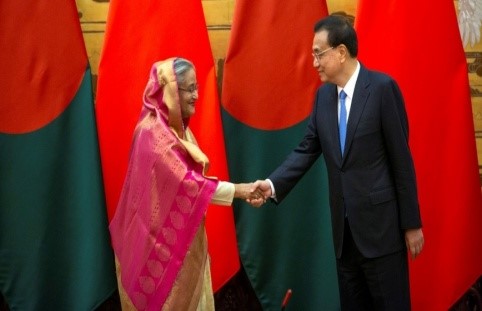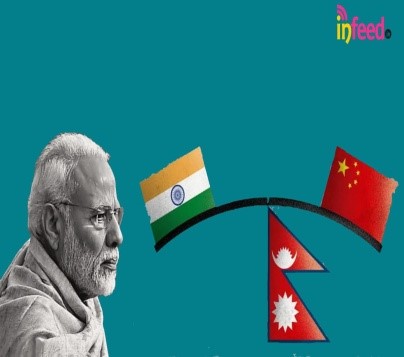
CHINA LED SOUTH ASIAN INITIATIVE
CHINA-LED SOUTH ASIAN INITIATIVE

Recently, Bangladesh has invited India to join the China-led South Asian initiative for Covid-19 vaccines and poverty alleviation. It includes the creation of the China-South Asian Countries Emergency Supplies Reserve, and a Poverty Alleviation and Cooperative Development Centre set up in China.
ABOUT CHINA SOUTH ASIAN INITIATIVE
- Members: China, Afghanistan, Bangladesh, Nepal, Pakistan and Sri Lanka. India, Bhutan and the Maldives are the other SAARC countries that are not part of this initiative.
- Intended Vision: China has different kinds of strategic, maritime, political and ideological interests with different South Asian nations so it is increasing its engagements with each country on equal footing to counterbalance India.
- India’s Stand: Given continuing tensions over Chinese PLA aggression at the Line of Actual Control in Ladakh, India’s stand is that other bilateral relations cannot move ahead without a resolution of the boundary stand-off.
- Associated Issues: This initiative seems to be China 's strategy to contain and undermine India's role in South Asia. This can be reflected in the following arguments:
- Minus-India Initiative: Combinations of all SAARC member countries (other than India, Bhutan and Maldives) led some experts to suggest this was meant to be a “Minus India” initiative.
- Diluting India’s Role in South Asia: This initiative is one of China's attempts to make inroads into South Asia. The Chinese push to this regional grouping comes also at a time when India has been reluctant to revive SAARC, turning its focus more on yet another regional bloc–BIMSTEC.
- Countering Quad: The China-led bloc could be its plan to create what some call a northern Himalayan Quad aimed at countering the US-led Quad of which India is an active member.
India’s Initiatives for South Asia: In early 2021, India - driven by its ‘Neighbourhood First’ policy and in its understanding of its role as the ‘net security provider’ of the region began providing Covid-19 vaccines on a priority basis to its immediate neighbours (Vaccine Diplomacy). India is also helping with the training of health workers in some of these countries and the setting up of the infrastructure to administer the shots. Recently, India, Japan and Australia have formally launched the Supply Chain Resilience Initiative (SCRI). It aims to reduce dependence on China amid a likelihood of recurring of supply chains in the Indo-Pacific region amid the Covid-19 pandemic. However, India for years has struggled to match the pace of Chinese investment in countries such as Sri Lanka, Nepal and the Maldives, where China is building ports, roads and power stations as part of its Belt and Road Initiative. Recently, the Regional Comprehensive Economic Partnership (RCEP), a mega trade bloc comprising 15 countries led by China has come into existence. It has kept the doors for India open.
SUPPLY CHAIN RESILIENCE (CONCEPT)
In the context of international trade, supply chain resilience is an approach that helps a country to ensure that it has diversified its supply risk across a clutch of supplying nations instead of being dependent on just one or a few.
Importance: In unanticipated events -whether natural, such as volcanic eruptions, tsunamis, earthquakes or even a pandemic; or manmade, such as an armed conflict in a region — that disrupt supplies from a particular country or even intentional halts to trade, could adversely impact economic activity in the destination country.
SUPPLY CHAIN RESILIENCE INITIATIVE

- The Covid-19 pandemic was having an unprecedented impact in terms of lives lost, livelihoods and economies affected, and that the pandemic had revealed supply chain vulnerabilities globally and in the region.
- Objectives: To attract foreign direct investment to turn the Indo-Pacific into an “economic powerhouse”. To build a mutually complementary relationship among partner countries. To work out a plan to build on the existential supply chain network. Japan and India, for example, have an India-Japan competitiveness partnership dealing with locating the Japanese companies in India.
- Features: The SCRI, first proposed by Japan, aims to reduce dependence on China amid a likelihood of rechurning of supply chains in the Indo-Pacific region amid the Covid-19 pandemic. Initially, SCRI will focus on sharing best practices on supply chain resilience and holding investment promotion events and buyer-seller matching events to provide opportunities for stakeholders to explore the possibility of diversification of their supply chains. Joint measures may include supporting the enhanced utilisation of digital technology and trade and investment diversification. Expansion of the SCRI may be considered based on consensus, if needed, in due course. The ministers have decided to convene at least once a year to provide guidance to the implementation and development of the SCRI. This assumes significance in the wake of Japan's keenness to onboard the ASEAN in the initiative, something that India has opposed. India wants to safeguard its interests from China’s indirect influence through the bloc (ASEAN) as it builds on its self-reliance through reduced dependence on imports.
CONCLUSION

- Establishing a Border Commission: Demarcation of Indian external boundaries is yet to be completed. Resolution of border disputes will pave way for stable regional integration. Thus, India must strive for resolution of borders by establishing a border commission.
- Broader Lens of Foregin Policy Goals: Integrating India’s regional economic and foreign policy remains a major challenge. Therefore, India should resist compromising bilateral relationships with neighbours for short economic interests.
- Improving Regional Connectivity: Regional connectivity must be pursued with greater vigour while security concerns being addressed through cost-effective, efficient and reliable technological measures which are in use in other parts of the world.
- Implementing Gujral’s Doctrine: India’ neighbourhood policy should be based on the principles of Gujral Doctrine. This would ensure India’s stature and strength cannot be isolated from the quality of its relations with its neighbours and there can be regional growth as well.
TEST YOURSELF
Q.1 Recently, which of the following countries has invited India to join the China-led South Asian initiative for Covid-19 vaccines and poverty alleviation?
- Maldives
- Myanmar
- Bangladesh: ANSWER
- None of the above
Q.2 Which of the following countries have formally launched the Supply Chain Resilience Initiative (SCRI) which aims to reduce dependence on China amid a likelihood of rechurning of supply chains in the Indo-Pacific region amid the Covid-19 pandemic?
- India, Japan, Australia: ANSWER
- India, United States of America, Japan
- Japan, USA, Australia
- None of the above
Q.3 Which of the following statements is/are incorrect in the context of the China's Belt & Road Initiative (BRI)?
- It was launched in 2016 and involves development and investment initiatives that would stretch from Asia to Europe and beyond: ANSWER
- More than 100 countries have signed agreements with China to cooperate in BRI projects like railways, ports, highways and other infrastructure.
- China has a plan to complete 4,000 km of railways and 10,000 km of highways within the Central Asian region as part of BRI.
- None of the above
Q.4 Which of the following is not a principal organ of the Organization 'South Asian Association for Regional Cooperation (SAARC)'?
- Standing Committee of Foreign Secretaries
- Council of Ministers
- SAARC Secretariat
- General Assembly: ANSWER
Q.5 Which of the following statements is/are correct in the reference to South Asian Association for Regional Cooperation (SAARC)?
- In 2007, Pakistan & Tajikistan joined SAARC and bringing the total number of members of SAARC up to eight.
- SAARC is association of (South Asian) for regional cooperation & was founded as a movement toward collective progress for the involved nations of South Asia: ANSWER
- The SAARC Secretariat was established in Manila, Philippines on 16 January 1987. Its role is to coordinate and monitor the implementation of SAARC activities.
- All of the above












0 Comment